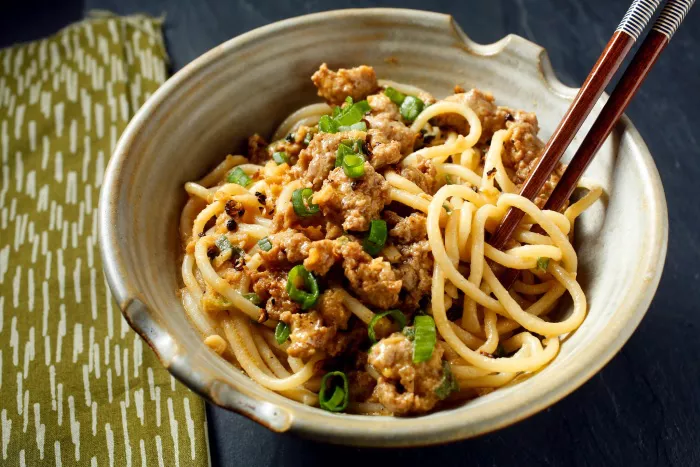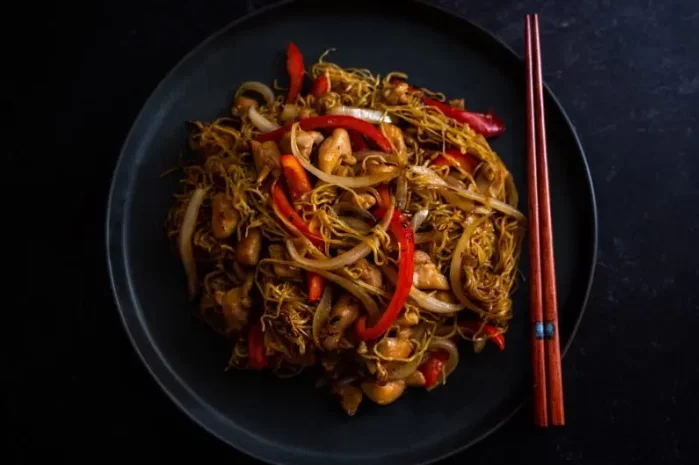Chinese cuisine is celebrated for its rich and diverse culinary heritage, and at the heart of this culinary tradition are Chinese noodles. Noodles have been an integral part of Chinese cuisine for thousands of years, and they come in a staggering array of shapes, sizes, and flavors. In this article, we embark on a fascinating journey to explore the wide and varied world of Chinese noodles, shedding light on the countless types that grace the tables across China and beyond.
I. Egg Noodles
Egg noodles, or “dan mian” (蛋面) in Mandarin, are perhaps the most recognizable and widely enjoyed type of Chinese noodles. These noodles are made with wheat flour and eggs, giving them a rich, golden hue and a slightly chewy texture. Egg noodles come in various thicknesses, from fine and delicate to wide and hearty.
Lo Mein: Lo Mein is a popular Chinese noodle dish made with egg noodles that are stir-fried with vegetables, proteins, and a savory sauce. It’s a versatile dish that can be customized with a wide range of ingredients, making it a favorite in Chinese-American restaurants.
Chow Mein: Chow Mein is similar to Lo Mein but often includes a crispy component. The noodles are stir-fried until they become crispy on the edges, providing a delightful contrast in texture.
Hong Kong-Style Egg Noodles: These thin and delicate egg noodles are commonly used in soups and stir-fry dishes. They are a staple in Cantonese cuisine and are known for their silky texture.
II. Wheat Noodles
Wheat noodles, also known as “mian” (面), are made from wheat flour and water, without the addition of eggs. They vary widely in terms of thickness and preparation methods, resulting in a diverse range of wheat-based Chinese noodles.
Lamian: Lamian, or hand-pulled noodles, are a marvel of Chinese noodle craftsmanship. Skilled chefs pull and stretch the dough into thin strands, resulting in noodles with a unique texture and mouthfeel. These noodles are often served in savory broths or stir-fried dishes.
Daoxiao Mian: Daoxiao Mian, or knife-cut noodles, are made by slicing sheets of dough into irregular, rustic shapes using a knife. They are commonly found in northern China and are prized for their hearty and chewy texture.
Youmian: Youmian, or oil-coated noodles, are a specialty of the Hakka cuisine. These noodles are typically stir-fried with ingredients like mushrooms, soy sauce, and minced pork, resulting in a flavorful and satisfying dish.
III. Rice Noodles
Rice noodles, known as “mi fen” (米粉) in Mandarin, are a staple in southern Chinese cuisine, particularly in regions like Guangdong and Guangxi. These noodles are made from rice flour and water, resulting in a soft, delicate texture.
Ho Fun: Ho Fun, also known as wide rice noodles, are broad, flat noodles often used in stir-fry dishes and soups. They are prized for their smooth, slippery texture and ability to absorb flavors from sauces and broths.
Vermicelli: Rice vermicelli, or “mi fen” (米粉), are thin rice noodles that are commonly used in dishes like spring rolls, stir-fries, and soups. They are quick to cook and have a light, delicate flavor.
Guilin Rice Noodles: A specialty of Guilin, these rice noodles are known for their spicy and tangy broth. They are often served with toppings like pickled vegetables, peanuts, and minced pork, creating a delightful balance of flavors and textures.
IV. Sweet Potato Noodles
Sweet potato noodles, also known as “fan shu mian” (番薯面), are made from sweet potato starch. These translucent noodles are prized for their chewy and slightly slippery texture.
Japchae: Japchae is a Korean dish that features sweet potato noodles stir-fried with vegetables and proteins. While it originated in Korea, it has gained popularity in Chinese cuisine as well.
Suan La Fen: Suan La Fen, or sour and spicy sweet potato noodles, is a popular street food in many parts of China. The noodles are served in a spicy and tangy broth, often accompanied by ingredients like tofu and pickled vegetables.
V. Bean Thread Noodles
Bean thread noodles, also known as “mung bean vermicelli” or “fen si” (粉丝) in Chinese, are made from mung bean starch. These thin, translucent noodles are prized for their ability to absorb the flavors of the dishes they are cooked in.
Ants Climbing a Tree: This Sichuan dish features bean thread noodles served with a spicy minced meat sauce. The name humorously refers to the appearance of the dish, where the minced meat clings to the noodles like ants on a tree.
Hot Pot Noodles: Bean thread noodles are a common addition to Chinese hot pot meals. They cook quickly in the hot broth and provide a delightful contrast to the other ingredients.
VI. Specialty Noodles
Chinese cuisine boasts a wide range of specialty noodles, each with its own unique characteristics and regional variations. These noodles often carry a rich cultural or historical significance.
Dan Dan Mian: Hailing from Sichuan province, Dan Dan Mian is a spicy noodle dish featuring ground pork, Sichuan peppercorns, and a flavorful chili sauce. It’s known for its bold and complex flavors.
Zha Jiang Mian: Zha Jiang Mian, or “fried sauce noodles,” is a classic Beijing dish. It consists of thick wheat noodles topped with a savory, bean-based sauce, along with vegetables and minced pork.
Liang Pi: Liang Pi, or cold skin noodles, are a specialty of Shaanxi province. These wide, flat noodles are served cold with a variety of toppings and a flavorful sauce, making them a refreshing and appetizing choice, especially during hot weather.
La Mian with Biang Biang Sauce: This dish features hand-pulled noodles served with a spicy and savory sauce known as “Biang Biang sauce.” It’s a specialty of Shaanxi cuisine and is named after the sound the noodles make when they are slapped against the table during preparation.
Conclusion
The world of Chinese noodles is a vast and fascinating one, with each type of noodle offering a unique culinary experience. From the delicate and silky egg noodles of Cantonese cuisine to the hearty knife-cut noodles of northern China, and from the chewy sweet potato noodles to the translucent bean thread noodles, Chinese noodles showcase the diversity and creativity of Chinese culinary traditions.
























